Kecheng Zheng
Vision-Centric Activation and Coordination for Multimodal Large Language Models
Oct 16, 2025Abstract:Multimodal large language models (MLLMs) integrate image features from visual encoders with LLMs, demonstrating advanced comprehension capabilities. However, mainstream MLLMs are solely supervised by the next-token prediction of textual tokens, neglecting critical vision-centric information essential for analytical abilities. To track this dilemma, we introduce VaCo, which optimizes MLLM representations through Vision-Centric activation and Coordination from multiple vision foundation models (VFMs). VaCo introduces visual discriminative alignment to integrate task-aware perceptual features extracted from VFMs, thereby unifying the optimization of both textual and visual outputs in MLLMs. Specifically, we incorporate the learnable Modular Task Queries (MTQs) and Visual Alignment Layers (VALs) into MLLMs, activating specific visual signals under the supervision of diverse VFMs. To coordinate representation conflicts across VFMs, the crafted Token Gateway Mask (TGM) restricts the information flow among multiple groups of MTQs. Extensive experiments demonstrate that VaCo significantly improves the performance of different MLLMs on various benchmarks, showcasing its superior capabilities in visual comprehension.
VideoMAR: Autoregressive Video Generatio with Continuous Tokens
Jun 18, 2025Abstract:Masked-based autoregressive models have demonstrated promising image generation capability in continuous space. However, their potential for video generation remains under-explored. In this paper, we propose \textbf{VideoMAR}, a concise and efficient decoder-only autoregressive image-to-video model with continuous tokens, composing temporal frame-by-frame and spatial masked generation. We first identify temporal causality and spatial bi-directionality as the first principle of video AR models, and propose the next-frame diffusion loss for the integration of mask and video generation. Besides, the huge cost and difficulty of long sequence autoregressive modeling is a basic but crucial issue. To this end, we propose the temporal short-to-long curriculum learning and spatial progressive resolution training, and employ progressive temperature strategy at inference time to mitigate the accumulation error. Furthermore, VideoMAR replicates several unique capacities of language models to video generation. It inherently bears high efficiency due to simultaneous temporal-wise KV cache and spatial-wise parallel generation, and presents the capacity of spatial and temporal extrapolation via 3D rotary embeddings. On the VBench-I2V benchmark, VideoMAR surpasses the previous state-of-the-art (Cosmos I2V) while requiring significantly fewer parameters ($9.3\%$), training data ($0.5\%$), and GPU resources ($0.2\%$).
Aligned Better, Listen Better for Audio-Visual Large Language Models
Apr 02, 2025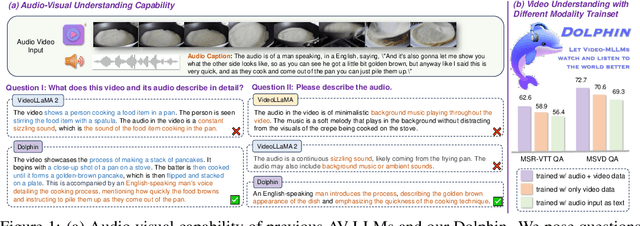

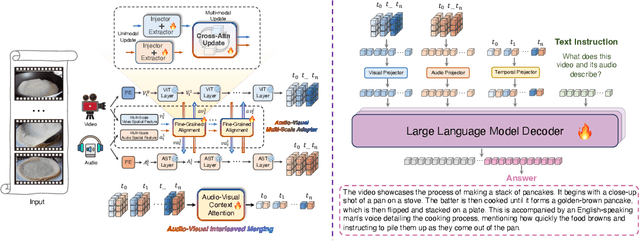
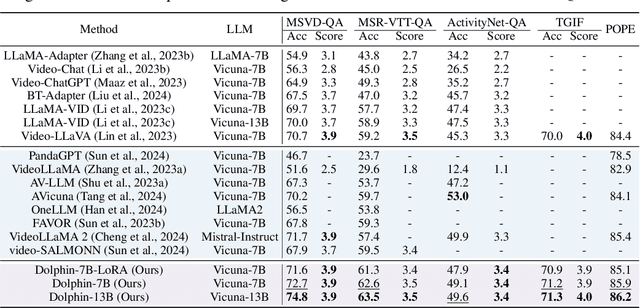
Abstract:Audio is essential for multimodal video understanding. On the one hand, video inherently contains audio, which supplies complementary information to vision. Besides, video large language models (Video-LLMs) can encounter many audio-centric settings. However, existing Video-LLMs and Audio-Visual Large Language Models (AV-LLMs) exhibit deficiencies in exploiting audio information, leading to weak understanding and hallucinations. To solve the issues, we delve into the model architecture and dataset. (1) From the architectural perspective, we propose a fine-grained AV-LLM, namely Dolphin. The concurrent alignment of audio and visual modalities in both temporal and spatial dimensions ensures a comprehensive and accurate understanding of videos. Specifically, we devise an audio-visual multi-scale adapter for multi-scale information aggregation, which achieves spatial alignment. For temporal alignment, we propose audio-visual interleaved merging. (2) From the dataset perspective, we curate an audio-visual caption and instruction-tuning dataset, called AVU. It comprises 5.2 million diverse, open-ended data tuples (video, audio, question, answer) and introduces a novel data partitioning strategy. Extensive experiments show our model not only achieves remarkable performance in audio-visual understanding, but also mitigates potential hallucinations.
Benchmarking Large Vision-Language Models via Directed Scene Graph for Comprehensive Image Captioning
Dec 12, 2024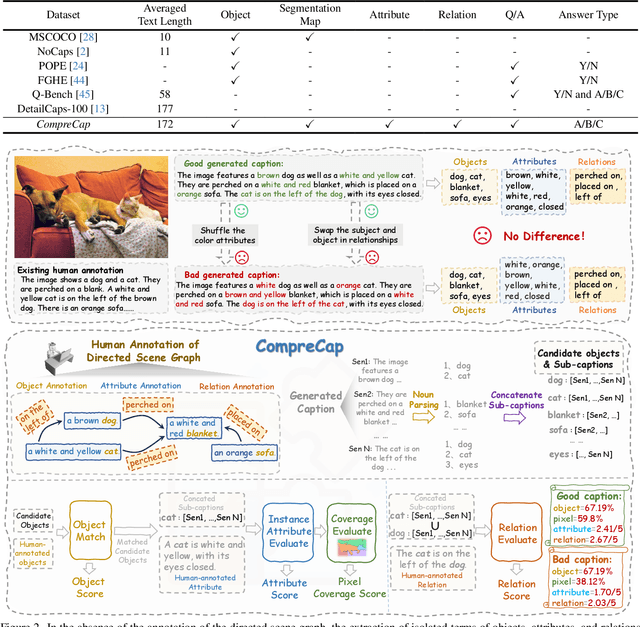
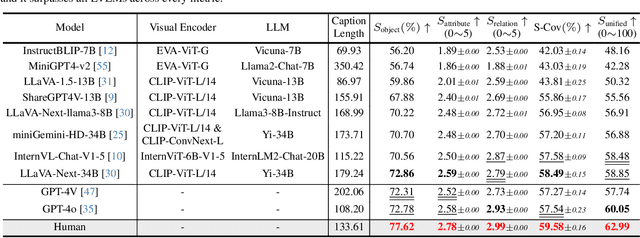
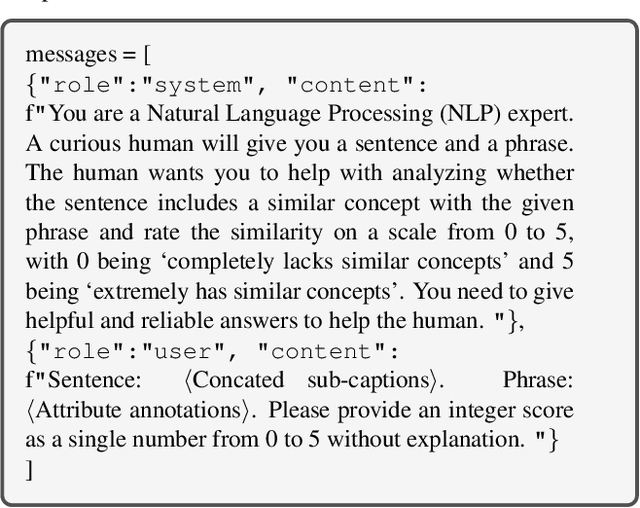
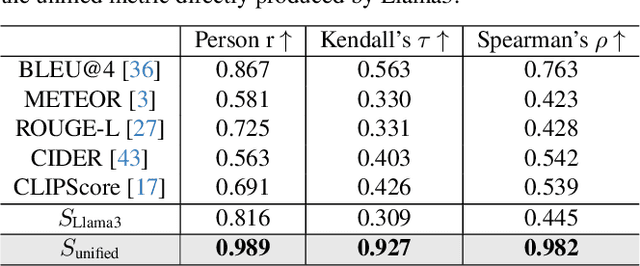
Abstract:Generating detailed captions comprehending text-rich visual content in images has received growing attention for Large Vision-Language Models (LVLMs). However, few studies have developed benchmarks specifically tailored for detailed captions to measure their accuracy and comprehensiveness. In this paper, we introduce a detailed caption benchmark, termed as CompreCap, to evaluate the visual context from a directed scene graph view. Concretely, we first manually segment the image into semantically meaningful regions (i.e., semantic segmentation mask) according to common-object vocabulary, while also distinguishing attributes of objects within all those regions. Then directional relation labels of these objects are annotated to compose a directed scene graph that can well encode rich compositional information of the image. Based on our directed scene graph, we develop a pipeline to assess the generated detailed captions from LVLMs on multiple levels, including the object-level coverage, the accuracy of attribute descriptions, the score of key relationships, etc. Experimental results on the CompreCap dataset confirm that our evaluation method aligns closely with human evaluation scores across LVLMs.
Learning Visual Generative Priors without Text
Dec 10, 2024



Abstract:Although text-to-image (T2I) models have recently thrived as visual generative priors, their reliance on high-quality text-image pairs makes scaling up expensive. We argue that grasping the cross-modality alignment is not a necessity for a sound visual generative prior, whose focus should be on texture modeling. Such a philosophy inspires us to study image-to-image (I2I) generation, where models can learn from in-the-wild images in a self-supervised manner. We first develop a pure vision-based training framework, Lumos, and confirm the feasibility and the scalability of learning I2I models. We then find that, as an upstream task of T2I, our I2I model serves as a more foundational visual prior and achieves on-par or better performance than existing T2I models using only 1/10 text-image pairs for fine-tuning. We further demonstrate the superiority of I2I priors over T2I priors on some text-irrelevant visual generative tasks, like image-to-3D and image-to-video.
MotionStone: Decoupled Motion Intensity Modulation with Diffusion Transformer for Image-to-Video Generation
Dec 08, 2024



Abstract:The image-to-video (I2V) generation is conditioned on the static image, which has been enhanced recently by the motion intensity as an additional control signal. These motion-aware models are appealing to generate diverse motion patterns, yet there lacks a reliable motion estimator for training such models on large-scale video set in the wild. Traditional metrics, e.g., SSIM or optical flow, are hard to generalize to arbitrary videos, while, it is very tough for human annotators to label the abstract motion intensity neither. Furthermore, the motion intensity shall reveal both local object motion and global camera movement, which has not been studied before. This paper addresses the challenge with a new motion estimator, capable of measuring the decoupled motion intensities of objects and cameras in video. We leverage the contrastive learning on randomly paired videos and distinguish the video with greater motion intensity. Such a paradigm is friendly for annotation and easy to scale up to achieve stable performance on motion estimation. We then present a new I2V model, named MotionStone, developed with the decoupled motion estimator. Experimental results demonstrate the stability of the proposed motion estimator and the state-of-the-art performance of MotionStone on I2V generation. These advantages warrant the decoupled motion estimator to serve as a general plug-in enhancer for both data processing and video generation training.
Mimir: Improving Video Diffusion Models for Precise Text Understanding
Dec 04, 2024



Abstract:Text serves as the key control signal in video generation due to its narrative nature. To render text descriptions into video clips, current video diffusion models borrow features from text encoders yet struggle with limited text comprehension. The recent success of large language models (LLMs) showcases the power of decoder-only transformers, which offers three clear benefits for text-to-video (T2V) generation, namely, precise text understanding resulting from the superior scalability, imagination beyond the input text enabled by next token prediction, and flexibility to prioritize user interests through instruction tuning. Nevertheless, the feature distribution gap emerging from the two different text modeling paradigms hinders the direct use of LLMs in established T2V models. This work addresses this challenge with Mimir, an end-to-end training framework featuring a carefully tailored token fuser to harmonize the outputs from text encoders and LLMs. Such a design allows the T2V model to fully leverage learned video priors while capitalizing on the text-related capability of LLMs. Extensive quantitative and qualitative results demonstrate the effectiveness of Mimir in generating high-quality videos with excellent text comprehension, especially when processing short captions and managing shifting motions. Project page: https://lucaria-academy.github.io/Mimir/
MoTe: Learning Motion-Text Diffusion Model for Multiple Generation Tasks
Nov 29, 2024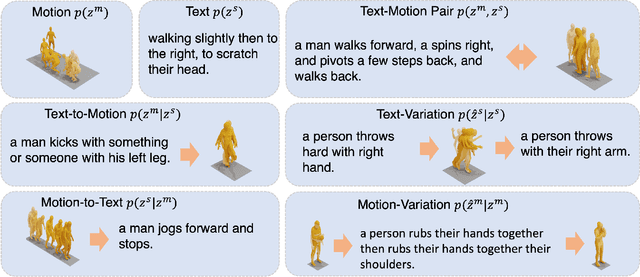

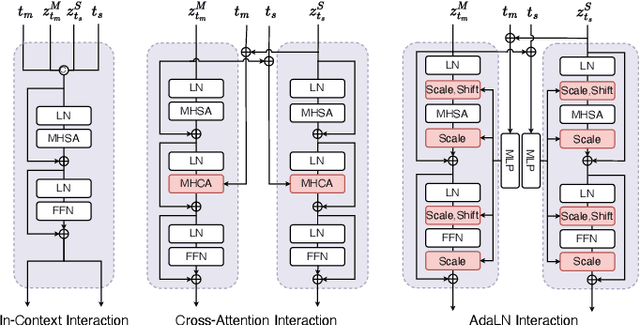

Abstract:Recently, human motion analysis has experienced great improvement due to inspiring generative models such as the denoising diffusion model and large language model. While the existing approaches mainly focus on generating motions with textual descriptions and overlook the reciprocal task. In this paper, we present~\textbf{MoTe}, a unified multi-modal model that could handle diverse tasks by learning the marginal, conditional, and joint distributions of motion and text simultaneously. MoTe enables us to handle the paired text-motion generation, motion captioning, and text-driven motion generation by simply modifying the input context. Specifically, MoTe is composed of three components: Motion Encoder-Decoder (MED), Text Encoder-Decoder (TED), and Moti-on-Text Diffusion Model (MTDM). In particular, MED and TED are trained for extracting latent embeddings, and subsequently reconstructing the motion sequences and textual descriptions from the extracted embeddings, respectively. MTDM, on the other hand, performs an iterative denoising process on the input context to handle diverse tasks. Experimental results on the benchmark datasets demonstrate the superior performance of our proposed method on text-to-motion generation and competitive performance on motion captioning.
Framer: Interactive Frame Interpolation
Oct 24, 2024
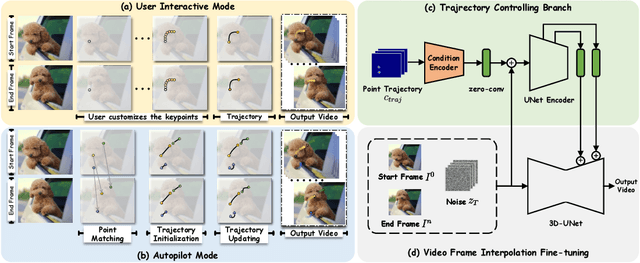


Abstract:We propose Framer for interactive frame interpolation, which targets producing smoothly transitioning frames between two images as per user creativity. Concretely, besides taking the start and end frames as inputs, our approach supports customizing the transition process by tailoring the trajectory of some selected keypoints. Such a design enjoys two clear benefits. First, incorporating human interaction mitigates the issue arising from numerous possibilities of transforming one image to another, and in turn enables finer control of local motions. Second, as the most basic form of interaction, keypoints help establish the correspondence across frames, enhancing the model to handle challenging cases (e.g., objects on the start and end frames are of different shapes and styles). It is noteworthy that our system also offers an "autopilot" mode, where we introduce a module to estimate the keypoints and refine the trajectory automatically, to simplify the usage in practice. Extensive experimental results demonstrate the appealing performance of Framer on various applications, such as image morphing, time-lapse video generation, cartoon interpolation, etc. The code, the model, and the interface will be released to facilitate further research.
Animate-X: Universal Character Image Animation with Enhanced Motion Representation
Oct 14, 2024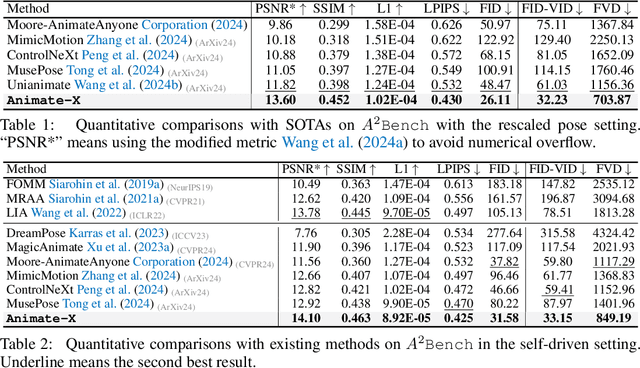
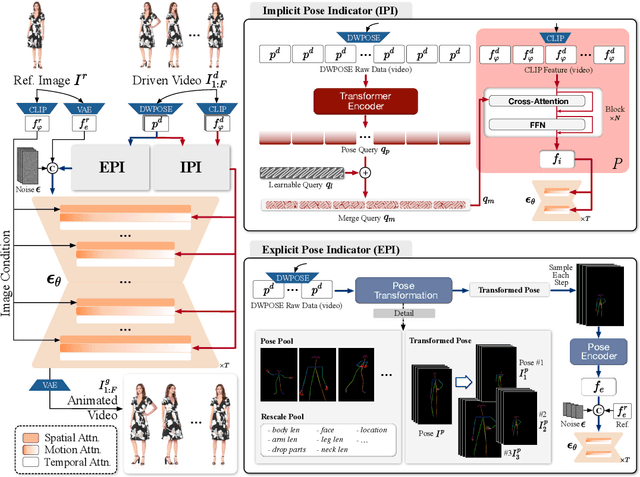
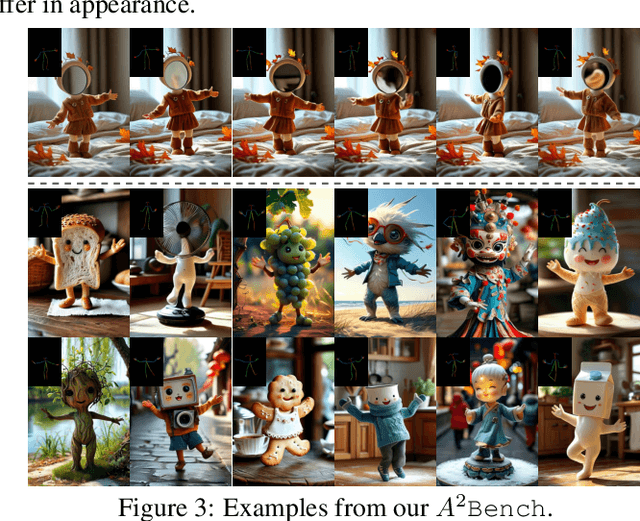
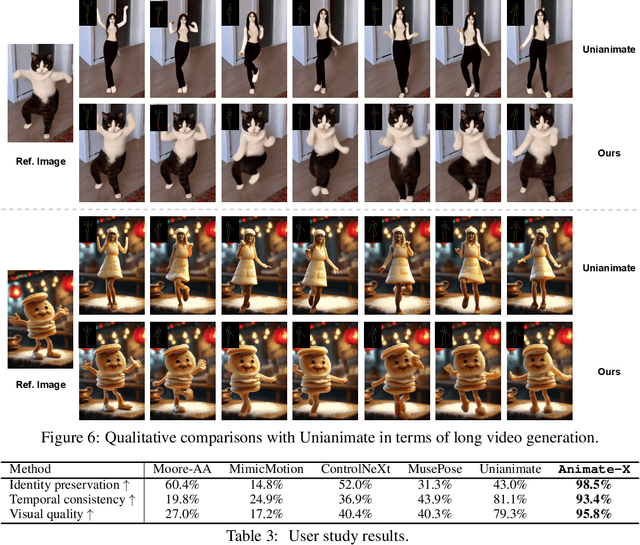
Abstract:Character image animation, which generates high-quality videos from a reference image and target pose sequence, has seen significant progress in recent years. However, most existing methods only apply to human figures, which usually do not generalize well on anthropomorphic characters commonly used in industries like gaming and entertainment. Our in-depth analysis suggests to attribute this limitation to their insufficient modeling of motion, which is unable to comprehend the movement pattern of the driving video, thus imposing a pose sequence rigidly onto the target character. To this end, this paper proposes Animate-X, a universal animation framework based on LDM for various character types (collectively named X), including anthropomorphic characters. To enhance motion representation, we introduce the Pose Indicator, which captures comprehensive motion pattern from the driving video through both implicit and explicit manner. The former leverages CLIP visual features of a driving video to extract its gist of motion, like the overall movement pattern and temporal relations among motions, while the latter strengthens the generalization of LDM by simulating possible inputs in advance that may arise during inference. Moreover, we introduce a new Animated Anthropomorphic Benchmark (A^2Bench) to evaluate the performance of Animate-X on universal and widely applicable animation images. Extensive experiments demonstrate the superiority and effectiveness of Animate-X compared to state-of-the-art methods.
 Add to Chrome
Add to Chrome Add to Firefox
Add to Firefox Add to Edge
Add to Edge